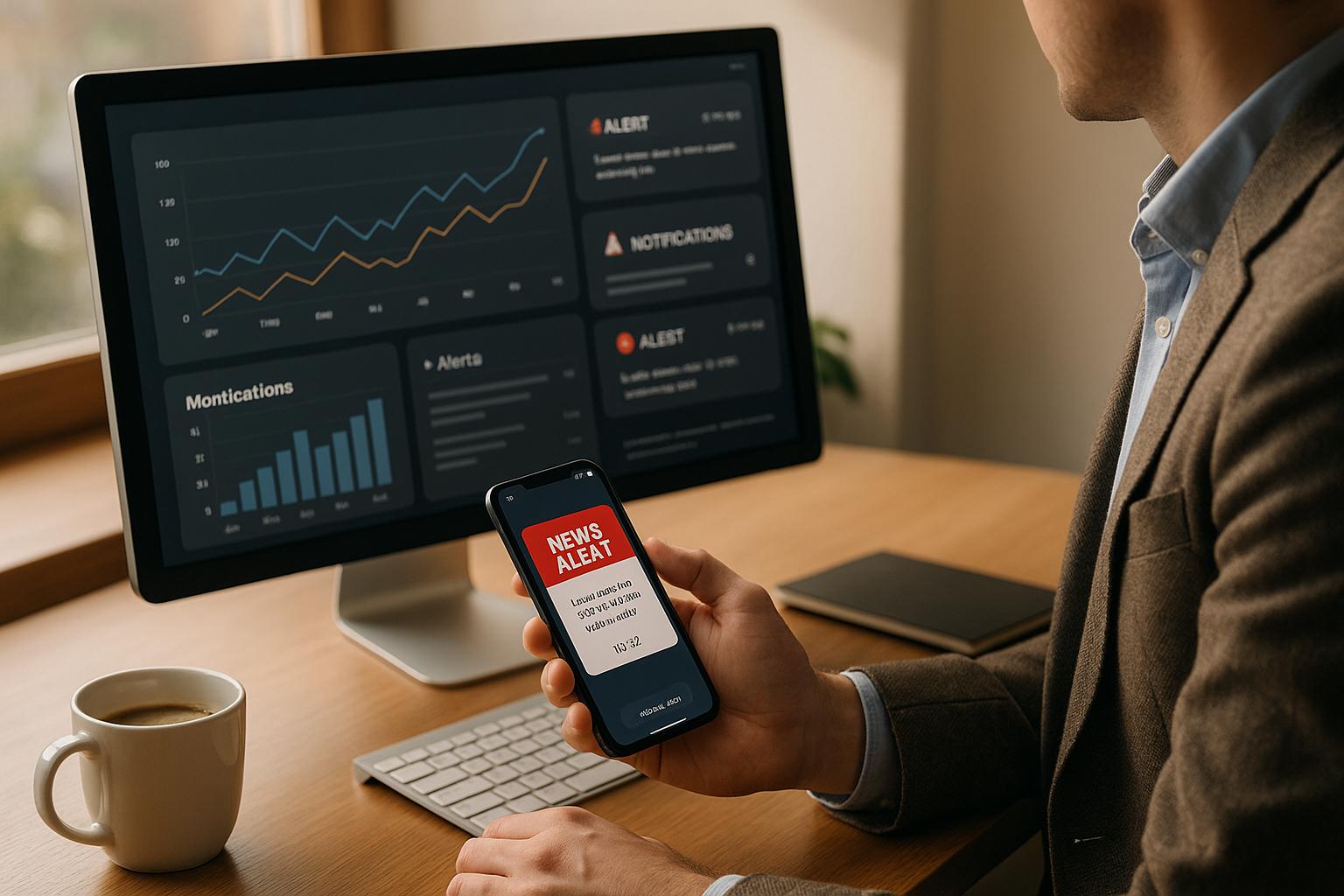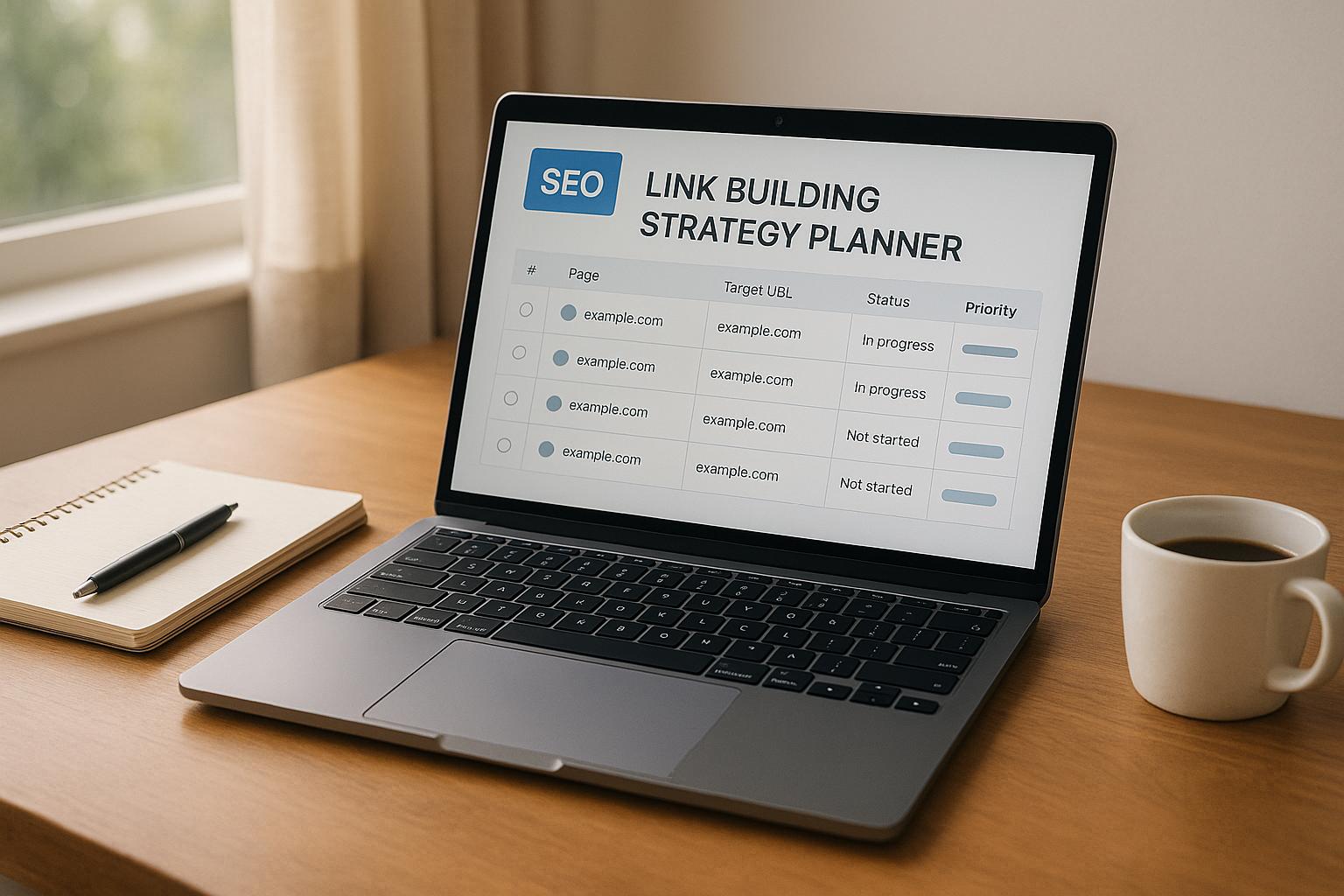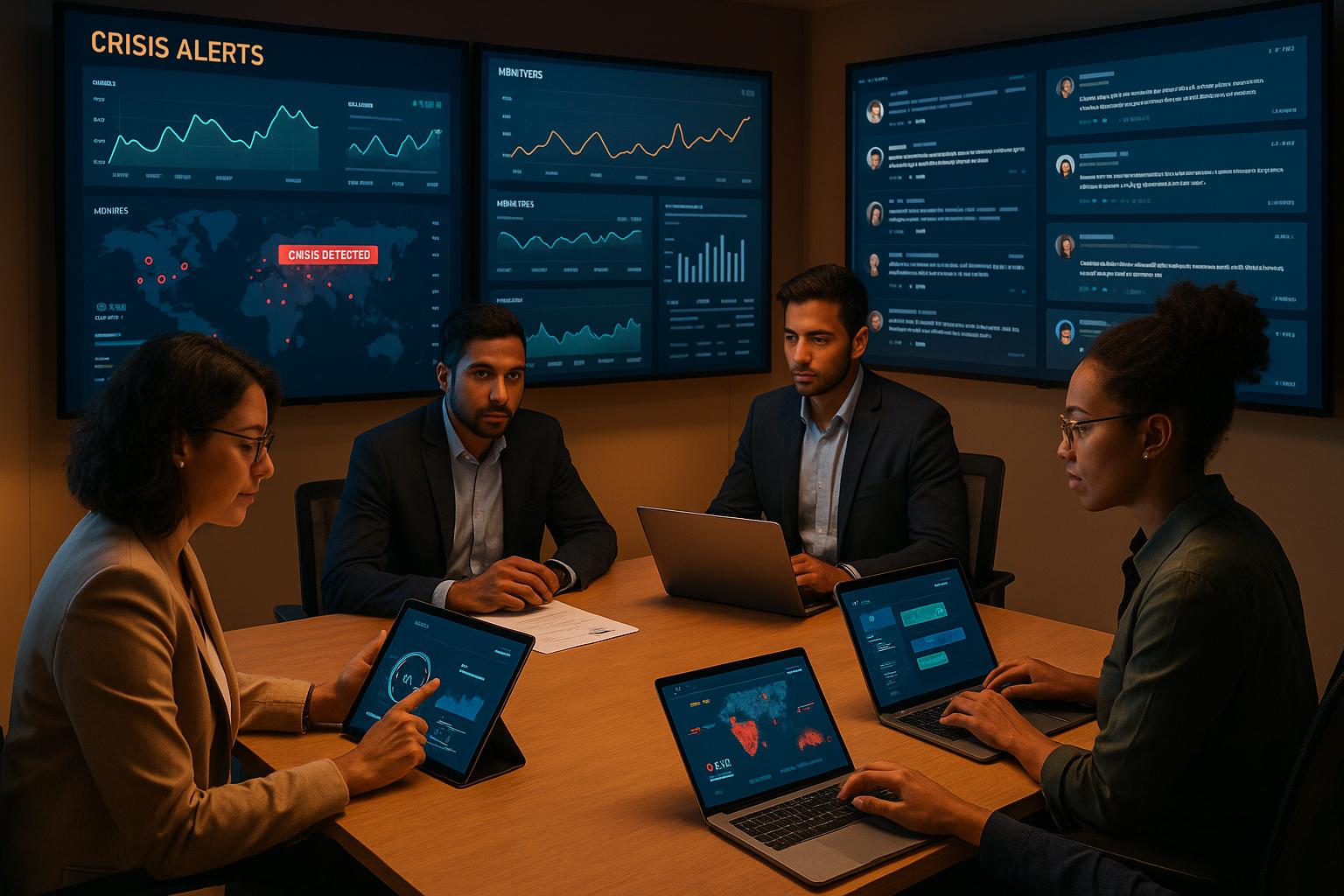AI-powered media monitoring tools help PR professionals track brand mentions, analyze sentiment, and detect trends in real time. These tools use advanced technologies like natural language processing (NLP) and machine learning to provide deeper insights beyond basic keyword searches. They scan news sites, social media, blogs, and even video or audio content to deliver actionable insights for managing brand reputation and responding to potential crises quickly.
Key Takeaways:
- Real-Time Tracking: Monitor mentions and sentiment shifts instantly across multiple platforms.
- Sentiment Analysis: Understand public perception with tools that analyze tone and context.
- Predictive Analytics: Spot emerging trends and potential risks before they escalate.
- Efficiency Gains: Automate repetitive tasks like data collection and reporting, saving time and resources.
- Cost-Effectiveness: AI tools reduce business costs compared to traditional PR methods.
By 2026, 80% of PR professionals expect to use AI tools, with early adopters already seeing benefits like faster responses, improved targeting, and better campaign outcomes. Tools such as Brand24, Mention, and Meltwater cater to different business needs, offering features like anomaly detection, media database access, and predictive analysis.
For businesses looking to integrate these tools, platforms like the AllDigitalPR Directory simplify the selection process by providing detailed comparisons and user reviews to ensure the right fit for your goals.
The Future of Media Monitoring: Using AI to deliver insights for impact // Infomedia
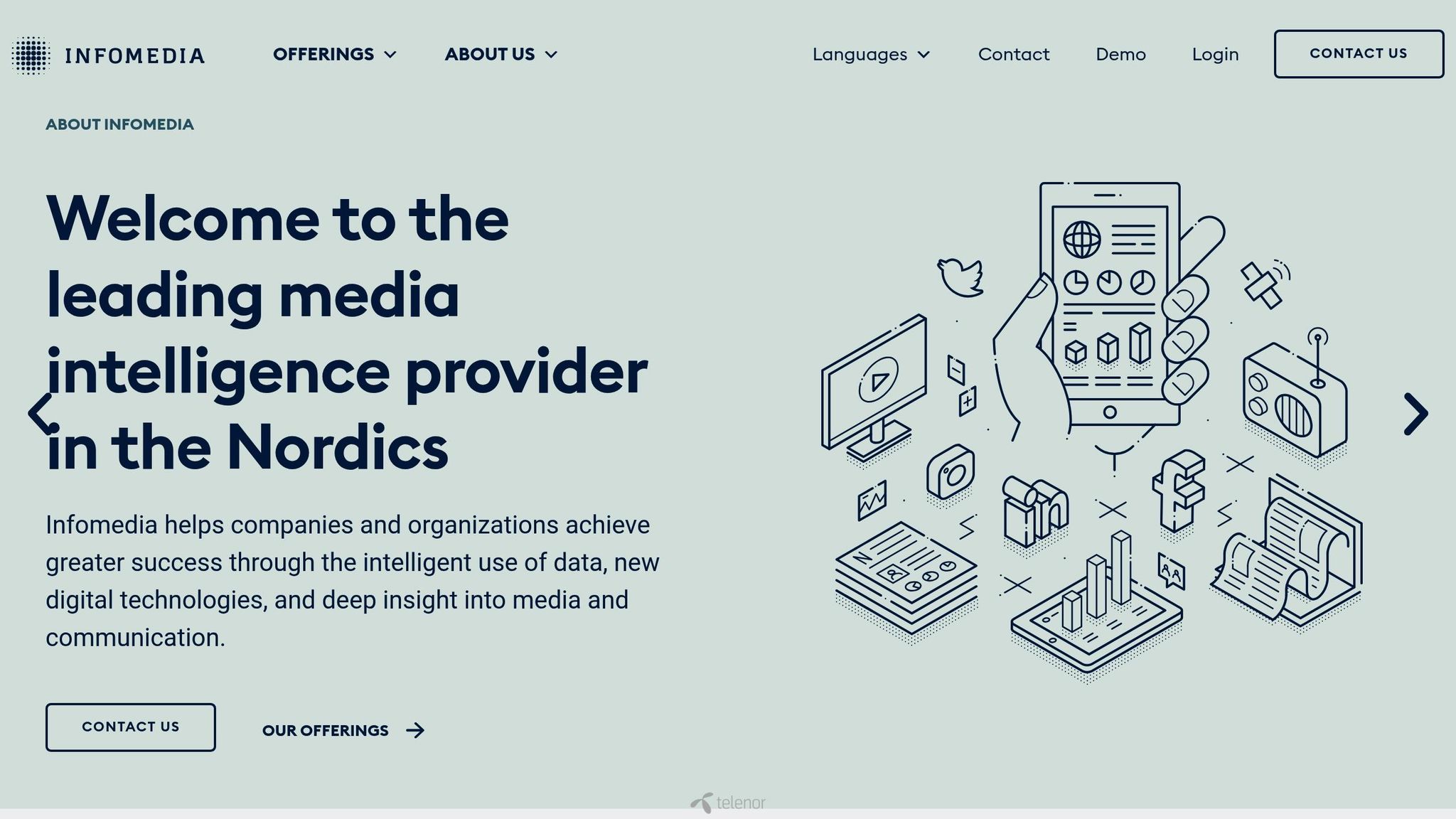
How AI-Powered Media Monitoring Tools Work
AI-powered media monitoring tools streamline how PR professionals transform raw digital data into actionable insights. These tools follow a structured process, bridging the gap between data collection and real-time strategic responses.
Data Collection and Aggregation
These tools are constantly scanning a wide range of digital sources to track mentions of brands, competitors, and industry-specific keywords. This continuous process organizes raw data into a structured, usable format.
With global data projected to reach 180 zettabytes by 2025, these tools play a crucial role in converting massive volumes of information into actionable insights. Data aggregation involves gathering information from sources like social networks, news articles, user-generated content, and even call centers through AI-powered speech recognition. To make the most of these tools, it’s vital to set up a comprehensive keyword list, including your brand name (and its common misspellings), product names, industry terms, competitor mentions, and campaign-specific hashtags.
Once aggregated, this structured data is processed using advanced linguistic algorithms to extract deeper insights.
Natural Language Processing and Sentiment Analysis
Natural Language Processing (NLP) takes structured data and transforms it into meaningful sentiment insights. This technology enables computers to understand and interpret human language, going beyond basic keyword detection to analyze context, tone, and meaning.
Sentiment analysis begins with NLP techniques that identify key features in the text, such as keywords and named entities. Machine learning models, trained on labeled datasets, then classify the information into categories like positive, negative, or neutral sentiment. By accounting for nuances in language, NLP significantly improves the accuracy of sentiment classification, achieving up to 85% accuracy in identifying sentiment polarity.
One notable finding is that fake news spreads on Twitter six times faster than truthful stories, often reaching a larger audience. Insights like these allow PR teams to identify and respond to misinformation trends before they spiral out of control.
Real-Time Monitoring and Alerts
What sets AI-powered tools apart is their ability to provide real-time insights. These systems continuously analyze data streams, instantly flagging unusual spikes in mentions or shifts in sentiment that require immediate attention. With the capacity to monitor over 10 million new stories daily and deliver alerts in under 200 milliseconds, these tools ensure PR teams are always in the loop.
Real-time alerts allow you to engage in social conversations as they unfold, address potential issues promptly, and stay ahead of critical developments. For instance, you can customize alert systems to monitor specific scenarios, such as mentions tied to crisis management or reputation risks. Spike detection features help identify trending topics or sudden surges in coverage of your brand, competitors, or industry. Alerts can be sent directly to your email, Slack, or mobile app, ensuring you’re always connected.
"In the era of complete digitization, monitoring the media in real time and quick reaction are the basics of our work, especially in crisis communication. Thanks to Determ, which scans our digital media space 24/7, we are informed about all important events right away, with notifications on the screen of our smartphones." – Kresimir Macan, CEO at Manjgura, PR agency
When choosing a platform, focus on features like real-time monitoring, sentiment analysis, automated reporting, API access for custom integrations, multi-platform compatibility, and scalable user accounts. These tools enable PR professionals to seamlessly integrate insights into their daily workflow, ensuring they remain proactive and informed.
Key Features and Benefits of AI-Powered Media Monitoring
AI-powered media monitoring tools bring a range of advanced capabilities that help PR professionals sharpen their strategies and maintain a strong digital presence. By combining real-time tracking with actionable insights, these tools are transforming how brands manage their reputation and respond to public sentiment.
Sentiment Analysis and Brand Reputation Management
One standout feature of these tools is sentiment analysis, which evaluates the emotional tone behind mentions of a brand. This helps PR teams gauge public perception across various platforms. What sets AI-driven sentiment analysis apart is its speed - it can process data 3–5 times faster than manual methods, leading to tangible results. For instance, 80% of companies report improvements in customer satisfaction and loyalty, while 75% see boosts in revenue and sales.
Unlike traditional methods that rely on keywords, AI sentiment analysis captures the context behind conversations. This deeper understanding is vital for reputation management, especially since 85% of customers trust online reviews as much as personal recommendations.
Consider the United Airlines crisis of 2017, when a video of a passenger being forcibly removed from a flight went viral. If AI-powered sentiment analysis had been in place, it could have detected the initial wave of negative sentiment, giving the company an opportunity to respond quickly and potentially limit the fallout. Early detection of sentiment shifts like this can stop small issues from spiraling into major crises.
Beyond monitoring sentiment, these tools also predict trends, allowing PR teams to stay ahead of the curve.
Predictive Analytics and Trend Forecasting
Another key strength of AI-powered tools is their ability to spot emerging trends before they gain widespread attention. By analyzing patterns across massive datasets, these tools help PR professionals anticipate shifts in public opinion, identify new opportunities, and craft proactive strategies. This forward-looking approach complements sentiment analysis by preparing teams for changes before they occur.
Predictive analytics rely on historical data and current media activity to forecast future developments. This gives PR teams the chance to align their strategies with upcoming trends rather than reacting after the fact. For example, identifying brand advocates and influencers early in a trend cycle provides an edge, allowing companies to connect with key voices before competitors do.
These tools also excel at crisis prevention. By analyzing sentiment patterns, conversation themes, and mention volumes, AI can flag potential risks in real-time - even during off-hours. This constant monitoring supports strategic decision-making through detailed share-of-voice analyses, SWOT evaluations, and brand comparisons, all drawn from vast media datasets.
Time and Cost Savings
AI doesn’t just provide insights - it also saves time and money. By automating repetitive tasks like creating media summaries and compiling reports, these tools free up PR teams to focus on strategy and relationship building. In fact, 65% of PR professionals already use AI in their work, with 61.4% of early adopters reporting greater efficiency. Additionally, 76.6% of users automate routine tasks, while 58.7% rely on AI to speed up research.
The financial benefits are equally compelling. For instance, in-house production using SaaS tools costs around $56,000 annually, compared to $153,960 per year for PR agencies. Thanks to AI, 43.5% of PR professionals report reduced business costs and resource needs. These savings come not only from lower labor costs but also from faster responses that prevent minor issues from escalating into expensive problems.
"AI is now an operational function, rather than a future tool you might buy." - Todd Murphy, Truescope Past President and PRSA Nebraska Member
The accessibility of AI tools, often through user-friendly interfaces, ensures that teams can quickly make data-driven decisions. This agility keeps everyone aligned and responsive to changing circumstances.
"When implemented strategically, AI will continue to streamline media monitoring workflows and enable PR professionals to derive greater value from their media intelligence." - Pragya Dubey, Vice President of Global Services at Agility PR Solutions
sbb-itb-3230277
Top AI-Powered Media Monitoring Tools
By 2025, brands are mentioned online every 3.2 seconds, with over 2.5 million publications expected by year-end. In 2024, North America led the global market with a 46.58% share, highlighting the importance of choosing the right tools for U.S. businesses.
Tool Comparison Chart
Here's a breakdown of some top AI-powered media monitoring tools tailored for U.S. businesses:
| Tool Name | Features | Pricing (USD) | Ideal Use Case |
|---|---|---|---|
| Brand24 | AI-driven sentiment analysis, anomaly detection, real-time alerts | From $149/month | Medium to large businesses needing deep social monitoring |
| Mention | Real-time tracking, historical data, team collaboration | From $41/month | Small to medium businesses focusing on brand mentions |
| Hootsuite | Social media analytics, scheduling, team management | From $99/month | Social media performance tracking and management |
| Cision Communications Cloud | Campaign management, media database, detailed analytics | $7,200–$18,000/year | Enterprise-level PR campaigns and media relations |
| Meltwater | Broad data coverage, offline/online channels, AI analysis | From $15,000/year | Large enterprises needing full-scale media intelligence |
| Talkwalker | Predictive analysis, visual recognition, corporate-focused | From $9,600/year | Enterprises requiring advanced forecasting capabilities |
| Sprout Social | All-in-one social management, advanced analytics | From $199/month | Medium to large businesses managing multiple social channels |
This chart provides a quick overview of how these tools cater to different business needs.
What Makes Each Tool Different
Each tool offers specific strengths that set it apart, depending on your business goals.
Brand24 is known for its AI-powered anomaly detection, which flags unusual spikes in mentions or sentiment shifts. It’s particularly effective for tracking conversations on news sites and forums, going beyond just social media. With a TrustRadius score of 8.9/10, users appreciate its easy-to-use interface and precise sentiment analysis.
Mention excels in real-time monitoring and offers access to historical data, making it ideal for tracking long-term brand perception. Its collaborative features simplify teamwork on campaigns, and its TrustRadius rating of 9.4/10 reflects strong user satisfaction.
Hootsuite focuses on social media, offering tools for performance tracking and management. It’s a go-to for businesses aiming to optimize their social strategies, with users rating it 8/10 on TrustRadius.
Cision Communications Cloud combines media monitoring with full PR campaign management. Its extensive media database and tools for managing media relationships make it a favorite among PR professionals handling large-scale campaigns.
Meltwater delivers comprehensive media intelligence by covering both online and offline channels. Its AI analysis helps businesses uncover trends and opportunities, making it a strong choice for enterprises with complex needs.
Talkwalker stands out for its predictive analysis and visual recognition technology, which tracks logo appearances and visual mentions across platforms. This makes it especially useful for large enterprises with intricate monitoring requirements.
Sprout Social provides an all-in-one solution for managing multiple social channels. Its advanced analytics help businesses refine their social strategies, making it a great fit for medium to large organizations.
"A media monitoring tool is no longer a nice-to-have. If you're treating your PR, marketing, reputation, and social media strategy seriously, such software matters a lot!"
– Katarzyna Dereń, Content Team Leader and Social Listening Expert at Brand24
While free tools like Google Alerts can handle basic tracking, they lack the advanced insights and AI-driven features that paid tools offer.
How AllDigitalPR Directory Helps
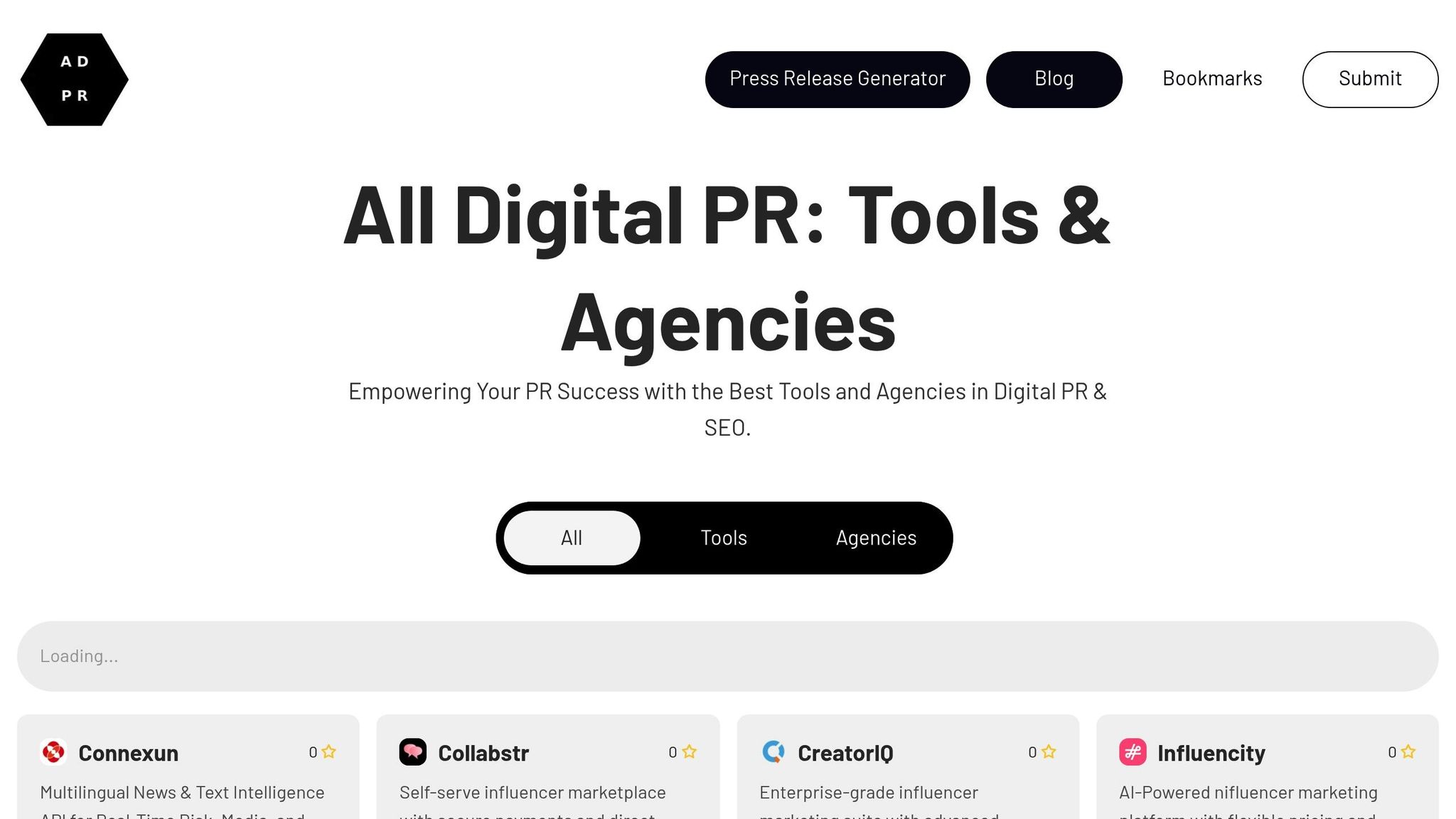
Choosing the right tool becomes simpler with the AllDigitalPR Directory. This platform serves as a one-stop resource where businesses can compare tools side by side, offering detailed reviews and insights to guide decisions.
The directory saves time by centralizing information about features, pricing, and user reviews. This is especially helpful given how varied and complex the media monitoring landscape can be, not to mention the significant investment these tools often require.
With filtering options based on budget, company size, and functionality, the directory ensures businesses find tools that match their specific needs. Whether it’s a small business looking for basic mention tracking or an enterprise needing full-scale media intelligence, AllDigitalPR Directory simplifies the process.
"Social media monitoring platforms are essential for businesses to stay informed, engage with their audience, and gather insights. With the right tools in place, brands can boost their brand equity and hit their marketing and business objectives."
– Marcelo Javelly, SEO and Social Listening Specialist, Cision
Adding AI Media Monitoring to Your PR Workflow
After exploring various AI tools, it’s time to dive into how you can bring AI media monitoring into your daily PR routine. To make the most of these tools, you’ll need a clear strategy, smart use of data, and a commitment to regular tweaking and improvement.
Setting Up and Customizing Monitoring Parameters
The first step in effective AI media monitoring is setting up the system to meet your specific goals. This process starts with clear planning and careful customization.
Start with Clear Objectives
Think about which repetitive tasks - like tracking mentions, creating reports, or drafting content - AI can handle for you. Decide whether you need a chatbot, automation tool, or analytics engine, depending on your goals.
Choosing Keywords and Tracking Competitors
Using the right keywords is crucial for monitoring mentions effectively. AI tools can suggest keywords that go beyond your brand name, such as product names, executive profiles, and industry-specific terms. Don’t forget to track competitor mentions too - this can provide valuable insights into their strategies and public perception.
Setting Sentiment Filters and Data Sources
Sentiment analysis is another key feature. It helps you understand whether mentions are positive, negative, or neutral. By scanning multiple platforms - social media, blogs, news sites, etc. - AI tools can offer a comprehensive view of public sentiment. Tailor your dashboards to ensure each department gets the insights most relevant to their work.
Training Your AI Assistant
Make sure your AI assistant understands your brand by training it with past press releases, tone guidelines, templates, and media lists. Craft clear prompts to guide the assistant’s responses, ensuring all AI-generated content aligns with your brand’s voice and messaging.
Once everything is set up, use the insights from your AI tool to fine-tune your overall PR strategies.
Using Data to Improve PR Strategies
Once your AI monitoring is up and running, it’s time to turn the data into actionable strategies that drive real results.
Real-Time Crisis Management
AI tools can send real-time alerts when there’s a spike in negative sentiment or brand mentions. This allows you to address potential crises quickly, before they spiral out of control.
Refining Campaigns with Sentiment Analysis
Sentiment analysis doesn’t just help with crisis management - it can also guide your messaging and improve your campaigns. For example, brands using AI for social media management have reported cutting content creation time in half, freeing up teams to focus on strategy.
Keeping an Eye on Competitors and Trends
AI tools can also track competitor activity and identify emerging trends in your industry. This gives you a chance to adjust your campaigns early and stay ahead of the curve.
Making Smarter Decisions with Data
AI-generated insights are powerful, but they work best when combined with human expertise. PR professionals should review AI reports and add their own analysis to ensure decisions are well-rounded and effective.
Creating Tailored Campaigns
AI tools allow you to develop personalized campaigns by extracting insights that are specific to your audience. Custom dashboards ensure every department gets the data they need to create more targeted and impactful strategies.
Support from AllDigitalPR Directory
To make the integration process smoother, resources like the AllDigitalPR Directory can be a huge help. It simplifies the complex world of AI tools, guiding you through selection and implementation.
Finding the Right Tools
The directory provides detailed comparisons of media monitoring tools, including features, pricing, and user reviews. This saves you time and helps you choose tools that fit your budget and needs.
Implementation Tips and Best Practices
Beyond selecting tools, the directory offers advice on integrating them into your existing workflow. It helps you avoid common mistakes and ensures you get the most out of your investment from day one.
Ongoing Support and Optimization
The AllDigitalPR Directory also provides training resources to help your team work effectively with AI tools. Regularly reviewing and updating your setup ensures you continue getting actionable insights. Plus, the directory’s filtering options make it easy to refine your monitoring criteria as your needs evolve.
With over half of organizations reporting cost savings through AI, choosing the right tools and strategies can lead to significant returns. The AllDigitalPR Directory ensures your decisions align with your goals and budget.
"When implemented strategically, AI will continue to streamline media monitoring workflows and enable PR professionals to derive greater value from their media intelligence."
– Pragya Dubey, Vice President of Global Services at Agility PR Solutions
Conclusion
AI-powered media monitoring tools have reshaped how PR professionals track brand mentions, analyze sentiment, and manage reputations. These tools provide instant insights that go far beyond the capabilities of traditional methods.
Consider this: about 65% of PR professionals already rely on AI for tasks like list building, content creation, and research. By processing massive amounts of data in real time, AI enables PR teams to spot patterns and trends that would be nearly impossible to uncover manually.
With 24/7 monitoring across multiple platforms, AI ensures that no mention slips through the cracks. When a potential issue arises, these tools send immediate alerts, giving teams the chance to act before a situation escalates. For instance, brands such as ZARA benefit from Determ’s AI-powered platform, Synthia, which delivers detailed summaries of mentions, sentiment analysis, and tone of voice insights. This helps brands gauge whether their campaigns are connecting with their audiences.
Beyond operational efficiency, AI also addresses a significant skills gap in the industry. Even though only 20.7% of professionals feel confident working with data, AI tools simplify the process by automatically extracting key insights like sentiment and contextual analysis.
For those looking to choose the right tools, the AllDigitalPR Directory is a practical resource. It offers side-by-side comparisons of media monitoring solutions, covering features, pricing, and user reviews, along with tips for successful implementation to help teams get the most out of their investment.
As the industry moves forward, AI will play a defining role in PR strategies. With 80% of professionals expecting to use AI tools by 2026, early adopters are positioned to gain a clear advantage. The combination of streamlined monitoring and actionable insights lays the groundwork for smarter, more effective PR strategies. Now is the time to embrace AI-powered media monitoring to boost efficiency, accuracy, and competitiveness.
FAQs
How do AI-powered media monitoring tools improve sentiment analysis compared to traditional methods?
AI-driven media monitoring tools are transforming how sentiment analysis is done, offering quicker and more precise insights compared to older methods. These tools use cutting-edge machine learning and deep learning algorithms to sift through massive amounts of data in real time. They can pick up on subtle emotional tones and complex language patterns that manual approaches often overlook.
With sentiment analysis automated, businesses can react swiftly to customer feedback, track public opinion, and make informed decisions to safeguard and improve their brand image. The speed and accuracy these tools provide far surpass traditional rule-based systems, making them a game-changer for modern PR and media strategies.
What are the main benefits of using AI-powered media monitoring tools in PR?
AI-powered media monitoring tools bring a host of benefits to modern PR strategies. By automating the process of tracking and analyzing media coverage, these tools free up valuable time for PR teams to concentrate on strategic planning and creative initiatives. Plus, they provide real-time insights into crucial metrics like brand mentions, audience sentiment, and potential issues, enabling quicker and more informed decisions.
On top of that, these tools improve precision by uncovering trends and patterns that might slip past manual analysis. This allows PR professionals to take a proactive approach to managing their brand's reputation, seizing emerging opportunities, and addressing risks more efficiently. Leveraging these tools empowers teams to operate smarter and stay ahead in today’s fast-moving media environment.
What should businesses consider when selecting an AI-powered media monitoring tool?
When choosing an AI-driven media monitoring tool, it's important to look for one that provides extensive coverage across key media channels, real-time updates, and advanced features like sentiment analysis and automated tagging. These capabilities can help deliver insights that are both relevant and actionable for your business.
You should also evaluate factors such as customization options, how easily the tool integrates with your current workflows, and its overall dependability. These elements play a crucial role in ensuring the tool supports your business objectives and strengthens your PR and media strategies.
